Murraya paniculata, also known as orange jasmine or orange jessamine, is an evergreen shrub or small tree that is very popular in India. Native to tropical Asia, Murraya paniculata thrives in the hot and humid climates found across much of India. It is valued for its shiny green leaves, fragrant white flowers, and use as an ornamental hedge or landscape plant. The leaves are also used fresh or dried as a flavoring in Indian cuisine.
Murraya paniculata is a medium-sized evergreen shrub that grows up to 6 meters tall. It has a rounded, spreading shape with dense branches. The leaves are compound, with 5-9 glossy dark green leaflets emerging from each stem.
During summer, murraya produces an abundance of sweetly fragrant white flowers. The flowers have 4-5 petals and yellow stamens. These blooms attract bees and other pollinators.
The fruits are small, round, and orange when ripe. However, the fruits are mostly decorative and not eaten. Murraya can be grown for its flowers and foliage.
This plant is native to tropical Asia and is also known as orange jasmine. It has been introduced to other tropical regions as an ornamental plant due to its popularity.
Growing Conditions
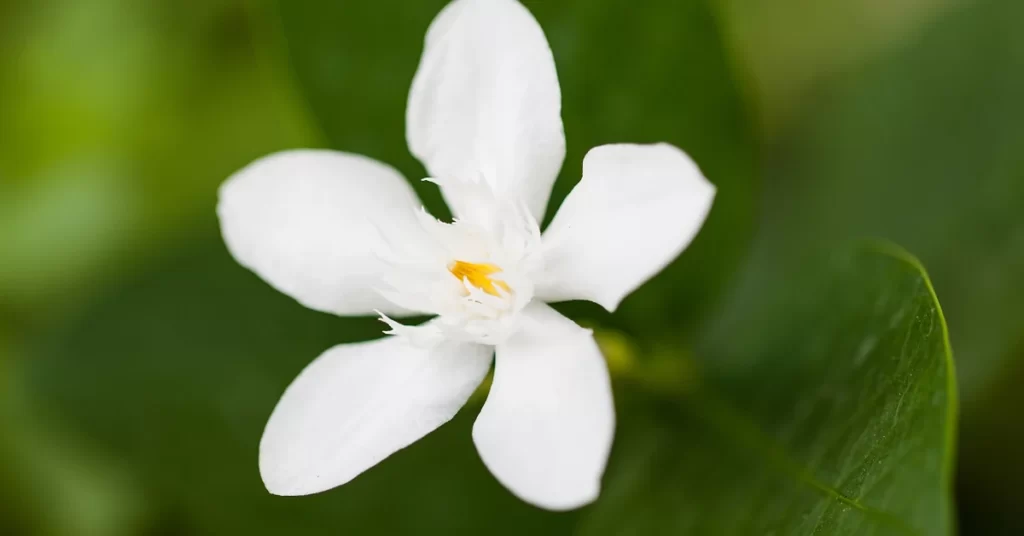
Climate and Location
Murraya paniculata grows best in USDA hardiness zones 10-12, preferring warm and humid tropical or subtropical climates. It can tolerate brief spells of cooler weather but is not frost hardy. Ideal growing conditions include daytime temperatures of 70-100°F and 60-90% humidity.
- Sunlight: Murraya needs full sun to partial shade. Provide 6-8 hours of sunlight daily.
- Soil: Well-draining, moderately fertile soil is ideal. Sandy loam or clay loam soil amended with compost works well.
- Temperature: Warm climate with temperatures between 10°C-38°C. Cannot tolerate frost.
- Water: Moderate watering to keep the soil moist, not soggy. Reduce water in winter.
- pH: Neutral to slightly acidic soil, pH 6.0-7.5.
- Flowers: Blooms in summer, flowers require sun.
In India, orange jasmine grows well across the central, eastern, and southern regions where the climate is hot and wet. It prefers partial shade in extremely hot climates but can thrive in full sun with adequate moisture. Good airflow and well-draining soil are essential.
Propagation

Murraya paniculata can be propagated from seeds, cuttings, or air layering.
Seeds – Seeds should be collected when ripe and sown immediately for the highest germination rates. Soak the seeds for 24 hours before sowing 1 inch deep in seed starting mix. Seeds take 1-2 months to germinate.
Cuttings – Take 6-8 inch semi-hardwood cuttings from healthy branches. Dip the cut end in rooting hormone and plant in seed starting mix. Keep humid until roots develop in 4-6 weeks.
Air layering – Make a 2 inch cut on a branch and wrap with sphagnum moss soaked in rooting hormone. Wrap the moss ball with plastic and secure. Roots will develop in 4-8 weeks at which point the branch can be cut and replanted.
Preparing to Plant
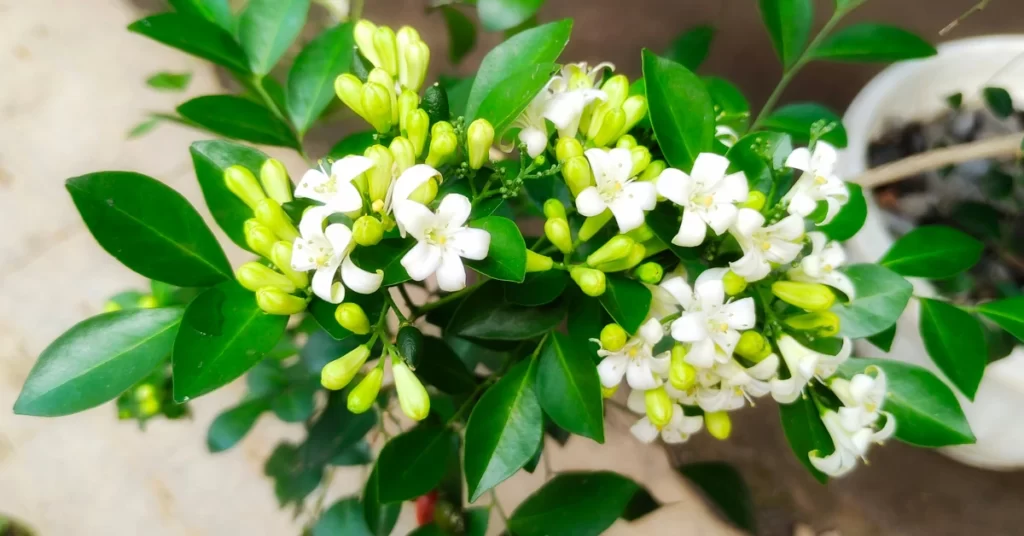
Proper planning and preparation ensures healthy murraya paniculata plants.
Choosing the Right Location
- Select a spot that receives full sun to partial shade for at least 6 hours daily.
- Check for good drainage by digging a hole and filling it with water. It should drain fully in 8-12 hours.
- Give each shrub about 1 – 1.5 meters of space from other plants and structures for adequate growth.
- Position near a fence or trellis for support if desired.
Preparing the Soil
- Test the soil pH and amend with lime to raise pH or sulfur to lower pH as needed.
- Till the top 12-15 inches of soil thoroughly to loosen and aerate.
- Mix in 2-3 inches of well-rotted compost or manure to enrich the soil.
- Rake smooth and remove any weeds, rocks or debris beforehand.
Selecting the Plants
- Purchase young murraya paniculata plants from a reputable nursery. Select plants that are 12-24 inches tall.
- Choose plants with healthy foliage and no signs of pests, disease or damage. Avoid root-bound plants.
- For dwarf varieties like Murraya Exotica, select smaller 6-12 inch plants.
Planting Murraya Paniculata
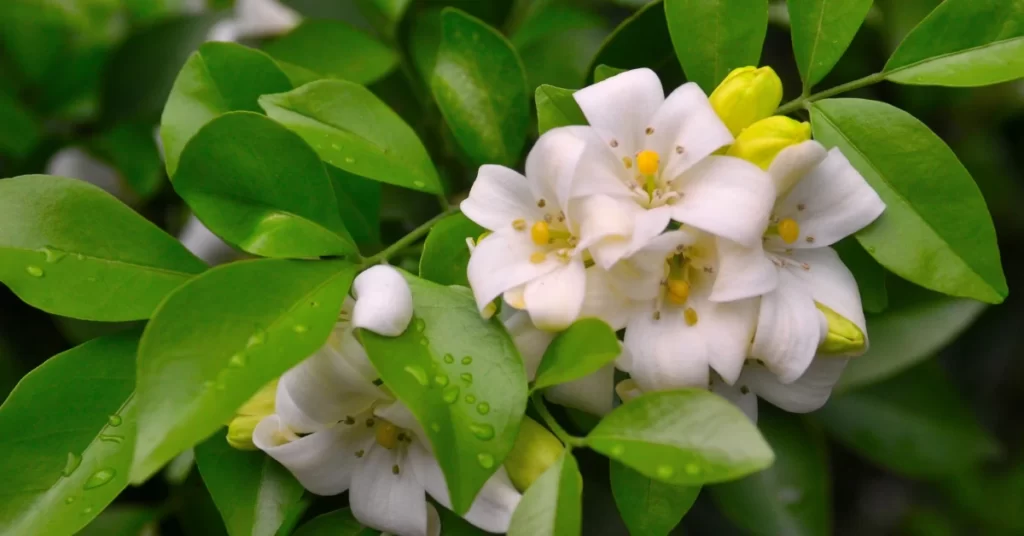
Once you have prepared the site and selected suitable plants, it’s time to plant them.
Digging Holes for Planting
- Dig holes 12-18 inches wide and deep for each murraya plant.
- Space holes 3-5 feet apart depending on desired plant size and hedge density.
- Mix some compost or organic fertilizer into the excavated soil.
Planting Steps
- Carefully remove the plant from the container without disturbing the root ball.
- Place into the hole so the top of root ball is level with the ground.
- Backfill the hole halfway and water well to settle the soil.
- Fill the remainder of hole, ensuring the plant is upright and at the proper level.
Watering after Planting
- Water thoroughly after planting to moisten the entire root zone.
- Add 2-3 inches of mulch around plants to retain moisture.
- Continue deep watering when top few inches become dry until established.
Care and Maintenance
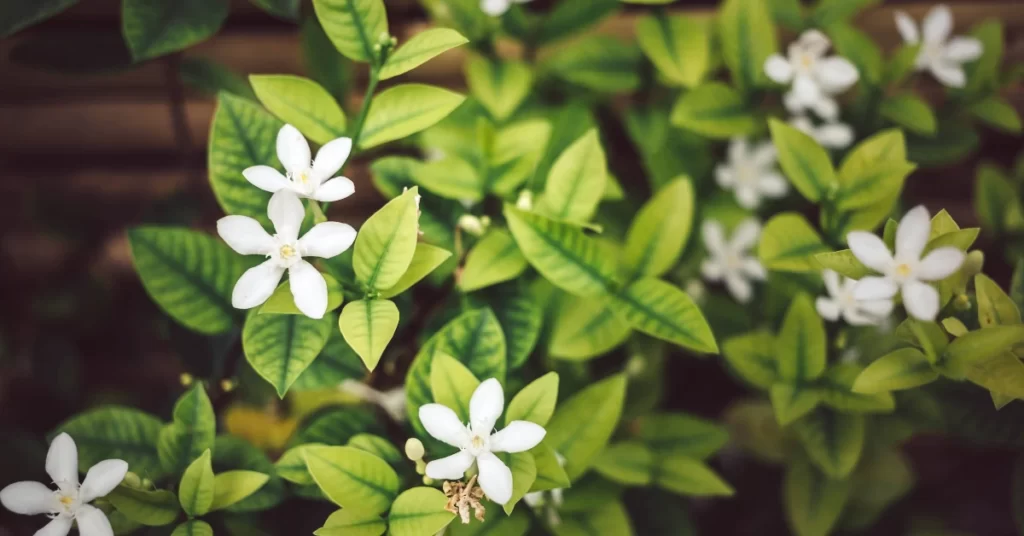
Watering
Orange jasmine needs regular watering to look its best. New plants should be watered daily for the first few weeks until established. Mature plants can be watered 2-3 times per week, avoiding waterlogged soil. Increase frequency during hot and dry periods. Leaves turning yellow or brown are signs of underwatering.
Pruning
Prune orange jasmine after flowering to shape hedges or shrubs. Trimming promotes bushy and compact growth. Remove any dead or diseased branches as needed.
Pests and Diseases
- Inspect regularly for common pests like aphids, scales, mealybugs and whiteflies.
- Treat with neem oil, insecticidal soap or appropriate organic pesticides if pests are found.
- Prevent fungal issues like leaf spots, rusts and powdery mildew with proper cultural practices.
- Remove and destroy any diseased or pest-infested parts promptly.
Fertilizing
Apply a balanced fertilizer every 2-3 months during the growing season. Compost or manure also provides nutrients. Avoid over-fertilizing which can cause excessive foliage growth.
Harvesting
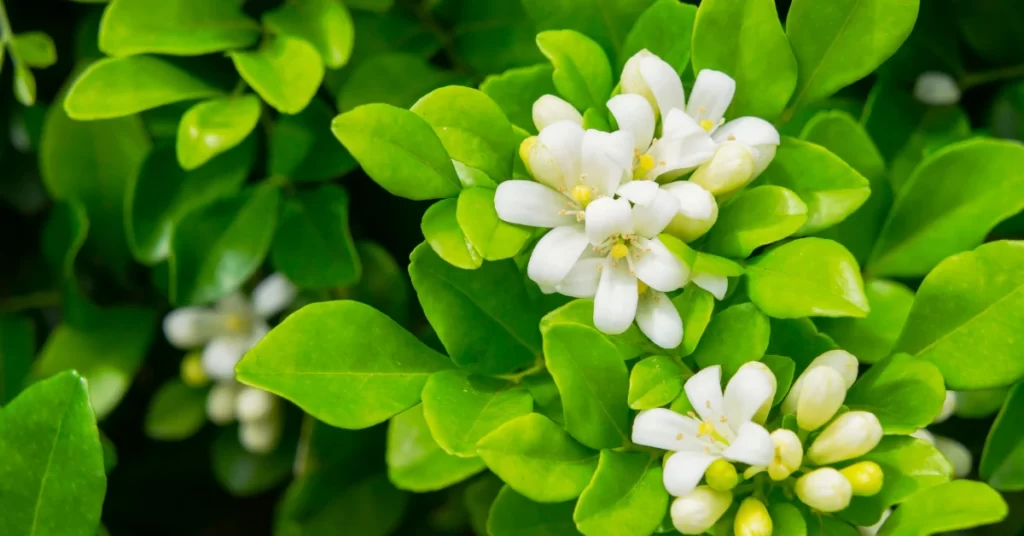
Harvest orange jasmine leaves as needed for fresh use in cooking. Pick individual leaves or prune branches. Flowers can be harvested for their fragrance when fully open. Always harvest early in the day.
Common Issues and Solutions

Here are some potential problems and how to resolve them:
Yellow leaves – Usually due to overwatering. Allow soil to dry out between watering.
Leaf spot – Caused by fungus. Improve air circulation and use fungicide.
Dropping leaves/flowers – Can be from insufficient water or sunlight. Adjust growing conditions.
Poor flowering – Increase sunlight and fertilization. Prune after flowering.
Root rot – Caused by overly wet soil. Improve drainage and avoid overwatering, to know more about root rot.
Conclusion
With its glossy evergreen foliage, sweetly fragrant blooms, and edible leaves, Murraya paniculata is a versatile shrub suited to many gardens and landscapes across India. Provide ample heat, humidity, and moisture along with good air circulation for successful growth. Train and prune murraya as a hedge or standalone specimen plant. Harvest the leaves and flowers to enjoy this tropical beauty.
FAQs
What are some common names for Murraya Paniculata?

Some other common names include orange jasmine, orange jessamine, satinwood, Chinese box, and cosmetic bark tree.
How fast does Murraya Paniculata grow?

Murraya paniculata is considered a fast growing shrub or small tree. When kept pruned as a hedge, it can grow up to 3 feet per year. Individual plants may reach up to 15 feet tall and wide when left unpruned.
Where should I plant my Murraya Paniculata?

Murraya paniculata does best in full sun to partial shade. It needs warm temperatures and humidity, along with well-draining soil. Shelter it from strong winds.
When is the best time to prune Murraya Paniculata?
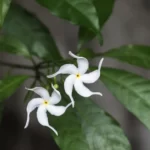
Prune orange jasmine after flowering during early spring. This encourages new growth and flowering for the next season. Avoid heavy pruning before frosts.
How do I propagate new Murraya Paniculata plants?
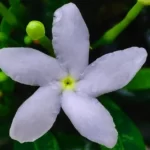
Orange jasmine can be grown from seeds, stem cuttings, air layering or grafting onto murraya rootstock. Taking semi-hardwood cuttings in spring is the easiest method for home gardeners.

1 thought on “How to Grow Murraya Paniculata in India?”